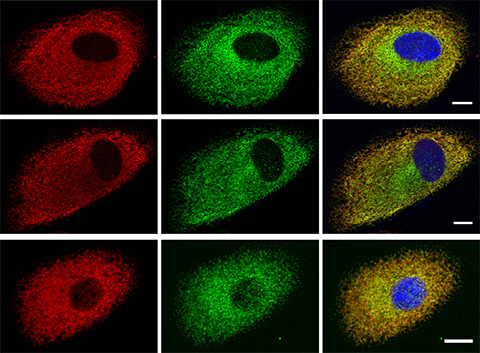ELOVL4 mutations: Two sides of the same coin
Fatty acids constitute cellular membranes, fuel energy production and act as signaling molecules. Long-chain fatty acids have tails of 13 to 21 carbons. The enzymes known as ELOVLs — short for “elongation of very long” — can extend these tails to make them into very long-chain saturated and very long-chain unsaturated fatty acids, known respectively as VLC-SFAs and VLC-PUFAs. Defects in the elongation of fatty acids can cause neuronal, ocular and skin problems.

Martin-Paul Agbaga, an assistant professor of cell biology and ophthalmology at the University of Oklahoma Health Sciences Center, studies the intersection between very long-chain fatty acids and human disease. In a recent publication in the Journal of Lipid Research, Agbaga and his team, which included Yeboah Kofi Gyening, described the mechanisms by which specific ELOVL4 mutations affect particular tissues.
“We are trying to figure out why some patients with ELOVL4 mutations only have retinal dysfunction, some only have brain dysfunction, and some only have skin dysfunction,” Gyening, a recent Ph.D. graduate, said. “We are basically asking why the same mutation is causing such diverse phenotypes.”
The team studied how two ELOVL4 mutants, one associated with brain disorders and the other with skin disease in humans, elongate a precursor fatty acid. They found that both these mutations had some limited capacity to elongate PUFA precursors to VLC-PUFA but blunted the enzyme’s capability to biosynthesize VLC-SFAs.
The question of how the same ELOVL4 can synthesize different VLCFAs in different tissues remains unanswered. “You can get some clues from fish,” Gyening explained. “Some fish species have two different ELOVL4 isoforms: ELOVL4a, which is more active in elongating VLC-SFAs, and ELOVL4b, which prefers VLC-PUFAs. Something similar could happen in humans, but we don’t know yet.”
In normal tissue, ELOVL4 is found in a cell’s endoplasmic reticulum, or ER, but these authors also found it in the nuclear fraction.
The team wondered whether ELOVL4-related disease results solely from a decline in certain VLC-SFAs or if mutated protein within the cells also plays a role. “We did some experiments that indicate that ELOVL4 mutants can induce ER stress,” Gyening said, “which could explain cell death observed in the cerebellum of some patients.”
These findings also could help determine treatment for patients with ELOVL4 deficiency. “In the lab, we were able to artificially synthesize VLCFAs to incorporate into the diet of rodents carrying ELOVL4 mutations, resulting in a partial rescue of the phenotype,” Gyening said. “Because we know which VLCFAs go down with the different ELOVL mutations, we could recommend personalized dietary supplementations as part of the treatment.”
Enjoy reading ASBMB Today?
Become a member to receive the print edition four times a year and the digital edition monthly.
Learn moreGet the latest from ASBMB Today
Enter your email address, and we’ll send you a weekly email with recent articles, interviews and more.
Latest in Science
Science highlights or most popular articles

E-cigarettes drive irreversible lung damage via free radicals
E-cigarettes are often thought to be safer because they lack many of the carcinogens found in tobacco cigarettes. However, scientists recently found that exposure to e-cigarette vapor can cause severe, irreversible lung damage.

Using DNA barcodes to capture local biodiversity
Undergraduate at the University of California, Santa Barbara, leads citizen science initiative to engage the public in DNA barcoding to catalog local biodiversity, fostering community involvement in science.

Targeting Toxoplasma parasites and their protein accomplices
Researchers identify that a Toxoplasma gondii enzyme drives parasite's survival. Read more about this recent study from the Journal of Lipid Research.

Scavenger protein receptor aids the transport of lipoproteins
Scientists elucidated how two major splice variants of scavenger receptors affect cellular localization in endothelial cells. Read more about this recent study from the Journal of Lipid Research.

Fat cells are a culprit in osteoporosis
Scientists reveal that lipid transfer from bone marrow adipocytes to osteoblasts impairs bone formation by downregulating osteogenic proteins and inducing ferroptosis. Read more about this recent study from the Journal of Lipid Research.

Unraveling oncogenesis: What makes cancer tick?
Learn about the ASBMB 2025 symposium on oncogenic hubs: chromatin regulatory and transcriptional complexes in cancer.

